782 have author last names that start with M have author last names that start with M
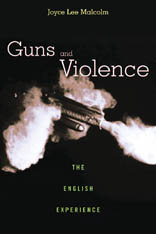
Behind the passionate debate over gun control and armed crime lurk assumptions about the link between guns and violence. Indeed, the belief that more guns in private hands means higher rates of armed crime underlies most modern gun control legislation. But are these assumptions valid?
Investigating the complex and controversial issue of the real relationship between guns and violence, Joyce Lee Malcolm presents an incisive, thoroughly researched historical study of England, whose strict gun laws and low rates of violent crime are often cited as proof that gun control works. To place the private ownership of guns in context, Malcolm offers a wide-ranging examination of English society from the Middle Ages to the late twentieth century, analyzing changing attitudes toward crime and punishment, the impact of war, economic shifts, and contrasting legal codes on violence. She looks at the level of armed crime in England before its modern restrictive gun legislation, the limitations that gun laws have imposed, and whether those measures have succeeded in reducing the rate of armed crime.
Malcolm also offers a revealing comparison of the experience in England experience with that in the modern United States. Today Americans own some 200 million guns and have seen eight consecutive years of declining violence, while the English--prohibited from carrying weapons and limited in their right to self-defense have suffered a dramatic increase in rates of violent crime.
This timely and thought-provoking book takes a crucial step in illuminating the actual relationship between guns and violence in modern society.
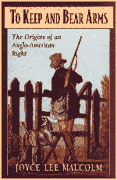
Joyce Malcolm illuminates the historical facts underlying the current passionate debate about gun-related violence, the Brady Bill, and the NRA, revealing the original meaning and intentions behind the individual right to “bear arms.” Few on either side of the Atlantic realize that this extraordinary, controversial, and least understood liberty was a direct legacy of English law. This book explains how the Englishmen’s hazardous duty evolved into a right, and how it was transferred to America and transformed into the Second Amendment.
Malcolm’s story begins in turbulent seventeenth-century England. She shows why English subjects, led by the governing classes, decided that such a dangerous public freedom as bearing arms was necessary. Entangled in the narrative are shifting notions of the connections between individual ownership of weapons and limited government, private weapons and social status, the citizen army and the professional army, and obedience and resistance, as well as ideas about civilian control of the sword and self-defense. The results add to our knowledge of English life, politics, and constitutional development, and present a historical analysis of a controversial Anglo-American legacy, a legacy that resonates loudly in America today.

Adál’s artistry is neither conventional nor pleasing for the spectator, as it is acquired through the continuous questioning of the particular condition of Puerto Ricans in the United States. The blurry portraits in this collection reflect the Nuyorican experience, but such a lesson becomes an ethical one: we are requested to learn to appreciate them in their opacity, because just as Rev. Pedro Pietri proclaims in the accompanying text, the Out of Focus Nuyoricans are proud “to not be figured out,” ever. If there is anything we should clearly get out of these out-of-focus portraits it is that to look fuzzy to some and opaque to others is not a condition to be feared or dreaded, but an achievement to be attained.
This book was published as a companion to the exhibits “Auto-Portraits/Blue Bananas on Fire” and “Blueprints for a Nation” at the David Rockefeller Center for Latin American Studies in 2004.

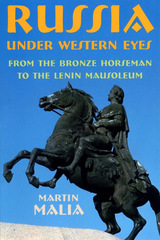
As the dust clears from the fall of Communism, will Western eyes see Russia, the unclaimed orphan of Western history or Russia as she truly is, a perplexing but undeniable member of the European family? A dazzling work of intellectual history by a world-renowned scholar, spanning the years from Peter the Great to the fall of the Soviet Union, this book gives us a clear and sweeping view of Russia not as an eternal barbarian menace but as an outermost, if laggard, member in the continuum of European nations.
The Russian troika hurtles through these pages. The Spectre, modernity's belief in salvation by revolutionary ideology, haunts them. Alice's looking glass greets us at this turn and that. Throughout, Martin Malia's inspired use of these devices aptly conveys the surreality of the whole Soviet Russian phenomenon and the West's unbalanced perception of it. He shows us the usually distorted images and stereotypes that have dominated Western ideas about Russia since the eighteenth century. And once these emerge as projections of the West's own internal anxieties, he shifts his focus to the institutional structures and cultural forms Russia shares with her neighbors.
Here modern Europe is depicted as an East-West cultural gradient in which the central and eastern portions respond to the Atlantic West's challenge in delayed and generally skewed fashion. Thus Russia, after two centuries of building then painfully liberalizing its Old Regime, in 1917 tried to leap to a socialism that would be more advanced and democratic than European capitalism. The result was a cruel caricature of European civilization, which mesmerized and polarized the West for most of this century. As the old East-West gradient reappears in genuinely modern guise, this brilliantly imaginative work shows us the reality that has for so long tantalized--and eluded--Western eyes.
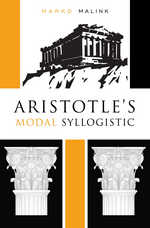
Aristotle was the founder not only of logic but also of modal logic. In the Prior Analytics he developed a complex system of modal syllogistic which, while influential, has been disputed since antiquity—and is today widely regarded as incoherent. In this meticulously argued new study, Marko Malink presents a major reinterpretation of Aristotle’s modal syllogistic. Combining analytic rigor with keen sensitivity to historical context, he makes clear that the modal syllogistic forms a consistent, integrated system of logic, one that is closely related to other areas of Aristotle’s philosophy.
Aristotle’s modal syllogistic differs significantly from modern modal logic. Malink considers the key to understanding the Aristotelian version to be the notion of predication discussed in the Topics—specifically, its theory of predicables (definition, genus, differentia, proprium, and accident) and the ten categories (substance, quantity, quality, and so on). The predicables introduce a distinction between essential and nonessential predication. In contrast, the categories distinguish between substantial and nonsubstantial predication. Malink builds on these insights in developing a semantics for Aristotle’s modal propositions, one that verifies the ancient philosopher’s claims of the validity and invalidity of modal inferences.
Malink recognizes some limitations of this reconstruction, acknowledging that his proof of syllogistic consistency depends on introducing certain complexities that Aristotle could not have predicted. Nonetheless, Aristotle’s Modal Syllogistic brims with bold ideas, richly supported by close readings of the Greek texts, and offers a fresh perspective on the origins of modal logic.

This book is a study of the variable perceptions of Greek collective identity, discussing ancient categories such as blood- and mythically-related primordiality, language, religion, and culture. With less emphasis on dichotomies between Greeks and others, the book considers complex middle grounds of intra-Hellenic perceptions, oppositional identities, and outsiders’ views. Although the authors do not seek to provide a litmus test of Greek identity, they do pay close attention to modern theories of ethnicity, its construction, function, and representation, and assess their applicability to views of Greekness in antiquity.
From the Archaic period through the Roman Empire, archaeological, anthropological, historical, historiographical, rhetorical, artistic, and literary aspects are studied. Regardless of the invented aspects of ethnicity, the book illustrates its force and validity in history.
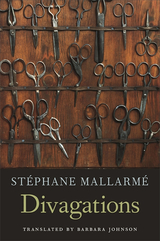
"This is a book just the way I don't like them," the father of French Symbolism, Stéphane Mallarmé, informs the reader in his preface to Divagations: "scattered and with no architecture." On the heels of this caveat, Mallarmé's diverting, discursive, and gorgeously disordered 1897 masterpiece tumbles forth--and proves itself to be just the sort of book his readers like most.
The salmagundi of prose poems, prose-poetic musings, criticism, and reflections that is Divagations has long been considered a treasure trove by students of aesthetics and modern poetry. If Mallarmé captured the tone and very feel of fin-de-siècle Paris, he went on to captivate the minds of the greatest writers of the twentieth century--from Valéry and Eliot to Paul de Man and Jacques Derrida. This was the only book of prose he published in his lifetime and, in a new translation by Barbara Johnson, is now available for the first time in English as Mallarmé arranged it. The result is an entrancing work through which a notoriously difficult-to-translate voice shines in all of its languor and musicality.
Whether contemplating the poetry of Tennyson, the possibilities of language, a masturbating priest, or the transporting power of dance, Mallarmé remains a fascinating companion--charming, opinionated, and pedantic by turns. As an expression of the Symbolist movement and as a contribution to literary studies, Divagations is vitally important. But it is also, in Johnson's masterful translation, endlessly mesmerizing.

This volume looks at the changing face of policy advising from the perspective of the author's forty years of work in and for developing countries. Both a personal memoir and an essay on the nature of the development profession, the book will be of particular interest to those just starting their careers as policy advisers.
The main lesson to be learned, says the author, is that "there is no common formula for solving a country's problems. Each society must come up with its own formula, in which economic policy is only one important variable in a complex equation. We missionaries can best help our counterparts carry out this daunting task by teaching more than preaching, and by insisting that they themselves take full responsibility for their recommendations and actions."
Richard D. Mallon is a Fellow Emeritus of the Harvard Institute for International Development. He has provided macroeconomic policy and planning advice in fifteen countries.

Argentina is a fascinating and baffling case to scholars of economic development. It has rich agricultural resources, a fully monetized economy, a domestic manufacturing sector that occupies a large share of the active labor force, a relatively high level of literacy, and other attributes that resemble a European nation more than a developing country. At the same time, Argentina has found it difficult to develop the institutions of a modern nation-state and to sustain a satisfactory rate of economic growth. This book is a new and vigorous attempt to explain the Argentinian paradoxes.
The authors' central hypothesis is that the conventional framework of economic analysis is ill-suited for policymaking in a pluralistic society; in such a society, successful macroeconomic policy management depends on support from viable political coalitions. In the absence of a repressive dictatorship, decision makers in Argentina, the authors maintain, have consistently attempted to adopt policy positions seemingly designed to tear society apart. Does this mean that no mediative policy alternatives exist which are more congenial to political pluralism? The authors present some answers to this important question by examining the Argentine balance of payments and stabilization policies. Their conclusions about macroeconomic policymaking are not only significant for Argentinian policymaking, but are also relevant for other semi-industrial societies.
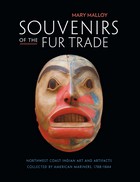
American mariners made more than 175 voyages to the Northwest Coast during the half-century after the ships Columbia and Washington pioneered the route from Boston in 1787. Although obtaining sea otter pelts for the China trade was the original purpose of the voyages, the art and culture of Northwest Coast Indians so intrigued and fascinated American sailors that the collecting of ethnographic artifacts became an important secondary trade. The Indians traded masks, hats, paddles, pipes, fishhooks, spoons, clothing, and canoe models from their canoes to the decks of Yankee vessels.
In this act of exchange, the artifacts moved from one world to another—first to shipboard, and later to the “cabinets of curiosities” of learned societies in Massachusetts, where many of them found homes. The objects were the first examples of Northwest Coast Indian material culture to enter American museums, and they influenced perceptions of Northwest Coast Indian people and their complex cultures.
By carefully researching the records of ten institutions and the shipboard journals of more than a dozen mariners, Mary Malloy has brought details about these early collections together for the first time. From utilitarian objects to artistic masterpieces, these souvenirs tell a story of commerce and cultural exchange that reached across the continent during the period when Americans were first beginning to look westward.

Mikhail Kuzmin (1872–1936), Russia’s first openly gay writer, stood at the epicenter of the turbulent cultural and social life of Petersburg-Petrograd-Leningrad for over three decades. A poet of the caliber of Aleksandr Blok, Vladimir Mayakovsky, Boris Pasternak, Osip Mandelshtam, and Marina Tsvetaeva (and acknowledged as such by them and other contemporaries), Kuzmin was also a prose writer, playwright, critic, translator, and composer who was associated with every aspect of modernism’s history in Russia, from Symbolism to the Leningrad avant-gardes of the 1920s.
Only now is Kuzmin beginning to emerge from the “official obscurity” imposed by the Soviet regime to assume his place as one of Russia’s greatest poets and one of this century’s most characteristic and colorful creative figures. This biography, the first in any language to be based on full and uncensored access to the writer’s private papers, including his notorious Diary, places Kuzmin in the context of his society and times and contributes to our discovery and appreciation of a fascinating period and of Russia’s long suppressed gay history.

Three foundational Roman poets.
The Loeb Classical Library series Fragmentary Republican Latin continues with three highly influential pioneers in the creation and development of Latin poetry.
Livius Andronicus (born ca. 292 BC) was regarded by the Romans as the founder of Latin literature, introducing tragedy and comedy, adapting Homer’s Odyssey into Saturnian verse, and composing a nationally important hymn for Juno. A meeting place for writers and actors was established in the temple of Minerva on the Aventine in recognition of his poetic achievements.
Naevius (born ca. 280–260), though most famous for his comedies, also wrote tragedy and epic. He innovated by incorporating Roman material into his Greek models and writing on Roman subjects independently. The inventor of the fabula praetexta, drama on a Roman theme, he also introduced new topics to Roman tragedy, especially those relating to Troy, and his Punic War, the first epic on a Roman historical subject, was a longtime school text and a favorite of Augustus.
Caecilius (born probably in the 220s), a friend of the older Ennius, excelled at comedy, of which he was Rome’s leading exponent during his career, and was so considered by posterity. Caecilius continued the Naevian practice of inserting Roman allusions into his works and was admired by later critics particularly for his substantive and well-constructed plots, and for his ability to arouse emotion.
The texts are based on the most recent and reliable editions of the source authors and have been revised, freshly translated, and amply annotated in light of current scholarship.
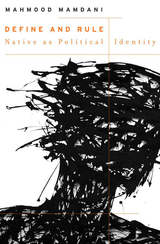
Define and Rule focuses on the turn in late nineteenth-century colonial statecraft when Britain abandoned the attempt to eradicate difference between conqueror and conquered and introduced a new idea of governance, as the definition and management of difference. Mahmood Mamdani explores how lines were drawn between settler and native as distinct political identities, and between natives according to tribe. Out of that colonial experience issued a modern language of pluralism and difference.
A mid-nineteenth-century crisis of empire attracted the attention of British intellectuals and led to a reconception of the colonial mission, and to reforms in India, British Malaya, and the Dutch East Indies. The new politics, inspired by Sir Henry Maine, established that natives were bound by geography and custom, rather than history and law, and made this the basis of administrative practice.
Maine’s theories were later translated into “native administration” in the African colonies. Mamdani takes the case of Sudan to demonstrate how colonial law established tribal identity as the basis for determining access to land and political power, and follows this law’s legacy to contemporary Darfur. He considers the intellectual and political dimensions of African movements toward decolonization by focusing on two key figures: the Nigerian historian Yusuf Bala Usman, who argued for an alternative to colonial historiography, and Tanzania’s first president, Mwalimu Julius Nyerere, who realized that colonialism’s political logic was legal and administrative, not military, and could be dismantled through nonviolent reforms.
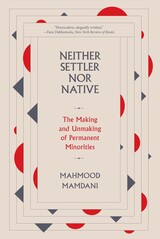
Prospect Top 50 Thinker of 2021
British Academy Book Prize Finalist
PROSE Award Finalist
“Provocative, elegantly written.”
—Fara Dabhoiwala, New York Review of Books
“Demonstrates how a broad rethinking of political issues becomes possible when Western ideals and practices are examined from the vantage point of Asia and Africa.”
—Pankaj Mishra, New York Review of Books
In case after case around the globe—from Israel to Sudan—the colonial state and the nation-state have been constructed through the politicization of a religious or ethnic majority at the expense of an equally manufactured minority. The model emerged in America, where genocide and internment on reservations created a permanent native minority. In Europe, this template would be used both by the Nazis and the Allies.
Neither Settler nor Native offers a vision for arresting this process. Mahmood Mamdani points to inherent limitations in the legal solution attempted at Nuremberg. Political violence demands political solutions: not criminal justice but a rethinking of the political community to include victims and perpetrators, bystanders and beneficiaries. Making the radical argument that the nation-state was born of colonialism, he calls on us to delink the nation from the state so as to ensure equal political rights for all who live within its boundaries.
“A deeply learned account of the origins of our modern world…Mamdani rejects the current focus on human rights as the means to bring justice to the victims of this colonial and postcolonial bloodshed. Instead, he calls for a new kind of political imagination…Joining the ranks of Hannah Arendt’s Imperialism, Frantz Fanon’s The Wretched of the Earth, and Edward Said’s Orientalism, this book is destined to become a classic text of postcolonial studies and political theory.”
—Moustafa Bayoumi, author of How Does It Feel to Be a Problem?
“A masterwork of historical comparison and razor-sharp political analysis, with grave lessons about the pitfalls of forgetting, moralizing, or criminalizing this violence. Mamdani also offers a hopeful rejoinder in a revived politics of decolonization.”
—Karuna Mantena, Columbia University
“A powerfully original argument, one that supplements political analysis with a map for our political future.”
—Faisal Devji, University of Oxford

This dazzling book takes us on a voyage of discovery around the world at the turn of the last millennium, when for the first time the world was in essence a unity. Islam bridged Eurasia, western Europe, and North Africa. Vikings, with links to Scandinavia and Russia, had just arrived in North America. These and other peoples reached out to create links and put isolated cultures unwittingly in touch. John Man vividly captures these epochal events, and depicts the colorful peoples that defined the world’s mix of stability and change, of isolation and contact. In an immensely learned portrayal, he traces enduring cultural strands that became part of the world as we know it today.
In text, maps, and pictures, most in color, and drawing on the expertise of two dozen consultants, John Man has created a concise compendium of all the major cultures of the lost millennial world of 1000. In some cultures—Europe, Islam, China, and Japan—written records contain a vast range of materials, often revealing sharply focused details of life and personality. Here lie startling contrasts with today’s world, and even foreshadowing of the future that are equally astonishing in their familiarity. For nonliterate cultures—in the United States, Southeast Asia, Polynesia, Africa—this book draws on a wealth of archeological research, some of it made available to nonspecialists for the first time.

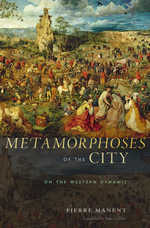
What is the best way to govern ourselves? The history of the West has been shaped by the struggle to answer this question, according to Pierre Manent. A major achievement by one of Europe's most influential political philosophers, Metamorphoses of the City is a sweeping interpretation of Europe's ambition since ancient times to generate ever better forms of collective self-government, and a reflection on what it means to be modern.
Manent's genealogy of the nation-state begins with the Greek city-state, the polis. With its creation, humans ceased to organize themselves solely by family and kinship systems and instead began to live politically. Eventually, as the polis exhausted its possibilities in warfare and civil strife, cities evolved into empires, epitomized by Rome, and empires in turn gave way to the universal Catholic Church and finally the nation-state. Through readings of Aristotle, Augustine, Montaigne, and others, Manent charts an intellectual history of these political forms, allowing us to see that the dynamic of competition among them is a central force in the evolution of Western civilization.
Scarred by the legacy of world wars, submerged in an increasingly technical transnational bureaucracy, indecisive in the face of proliferating crises of representative democracy, the European nation-state, Manent says, is nearing the end of its line. What new metamorphosis of the city will supplant it remains to be seen.

Ancient Egyptian history in Greek.
Manetho was an Egyptian of the third century BC. Born probably at Sebennytus in the Delta, he became a priest or high priest at Heliopolis. Apparently he and a Greek Timotheus did much to establish the cult of Serapis in Egypt. Eight works or parts of works were ascribed to him, all on history and religion and all apparently in Greek: Aegyptiaca, on the history of Egypt; The Sacred Book on Egyptian religion; An Epitome of Physical Doctrines; On Festivals; On Ancient Ritual and Religion; On the Making of Kyphi (an incense); The Criticisms of Herodotus; and the spurious Book of Sôthis. These survive only as quoted by other writers. This volume also contains the doubtful Kings of Thebes (in Egypt) and the Old Chronicle.

The Renaissance recovery of ancient biographical writers such as Plutarch, Suetonius, and Jerome led to a wave of imitations by Renaissance authors from Petrarch to Machiavelli. The orator, diplomat, and statesman Giannozzo Manetti (1396-1459), an expert in Greek and Hebrew as well as Latin, was among the leading humanist biographers of the Renaissance.
This collection brings together his famous biographies of Dante, Petrarch, and Boccaccio, which helped establish the canon of Italian literature, as well as his parallel lives of Socrates and Seneca, which remained the standard biographical sources for those philosophers throughout the early modern period. It also includes extended excerpts from two works, On Famous Men of Great Age and Against the Jews and the Gentiles, which contain biographical entries on a range of Italian literary figures from Brunetto Latini and Guido Cavalcanti to Coluccio Salutati and Leonardo Bruni.




Corn is among the most familiar of grains; it is also one of the most mysterious. In this handsomely illustrated new book, Paul Mangelsdorf, perhaps the world's foremost expert on the corn plant, summarizes the work of a lifetime devoted to unraveling the enigma of corn.
This unique grain--it has no close counterpart elsewhere in the plant kingdom--exists only in association with man, and it survives only as a result of his intervention. Thus, the story of corn is in many ways a story about people. Combining the skills of scientist and storyteller, Professor Mangelsdorf in his search for the origin of corn takes the reader to archaeological digs in once-inhabited caves in Mexico and the United States Southwest, to the discovery of fossil pollen in drill cores taken deep below Mexico City, and to experimental fields where the great diversity of corn is revealed and where the plant is hybridized with its relatives teosinte and Tripsacum.
Drawing upon the evidence from botany, genetics, cytology, archaeology, and history, the author seeks to evaluate various hypotheses on the origin of corn. He concludes that the ancestor of cultivated corn was a wild form of pod corn; that corn may have been domesticated more than once in both Mexico and South America from different geographical races of wild corn; and that hybridizations between corn and its various relatives have resulted in explosive evolution leading to a diversity of varieties and forms unmatched in any other crop plant.
This is a book about corn, but it is a book for biologists, agronomists, anthropologists, and historians, and for the interested layman who would like to know something about the grain which, "transformed, as three fourths of it is, into meat, milk, eggs, and other animal products, is our basic food plant, as it was of the people who preceded us in this hemisphere."


Poetry of the sky and stars.
Marcus Manilius, who lived in the reigns of Augustus and Tiberius, is the author of the earliest treatise on astrology we possess. His Astronomica, a Latin didactic poem in five books, begins with an account of celestial phenomena, and then proceeds to treat of the signs of the zodiac and the twelve temples; there follow instructions for calculating the horoscoping degree, and details of chronocrators, decans, injurious degrees, zodiacal geography, paranatellonta, and other technical matters. Besides exhibiting great virtuosity in rendering mathematical tables and diagrams in verse form, the poet writes with some passion about his Stoic beliefs and shows much wit and humor in his character sketches of persons born under particular stars. Perhaps taking a lead from Virgil in his Georgics, Manilius abandons the proportions of his last book to narrate the story of Perseus and Andromeda at considerable length.
In spite of its undoubted elegance, the Astronomica is a difficult work, and this edition provides in addition to the first English prose translation a full guide to the poem, with copious explanatory notes and illustrative figures.
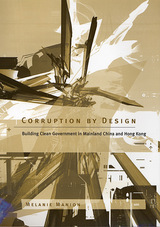
This book contrasts experiences of mainland China and Hong Kong to explore the pressing question of how governments can transform a culture of widespread corruption to one of clean government. Melanie Manion examines Hong Kong as the best example of the possibility of reform. Within a few years it achieved a spectacularly successful conversion to clean government. Mainland China illustrates the difficulty of reform. Despite more than two decades of anticorruption reform, corruption in China continues to spread essentially unabated.
The book argues that where corruption is already commonplace, the context in which officials and ordinary citizens make choices to transact corruptly (or not) is crucially different from that in which corrupt practices are uncommon. A central feature of this difference is the role of beliefs about the prevalence of corruption and the reliability of government as an enforcer of rules ostensibly constraining official venality. Anticorruption reform in a setting of widespread corruption is a problem not only of reducing corrupt payoffs, but also of changing broadly shared expectations of venality. The book explores differences in institutional design choices about anticorruption agencies, appropriate incentive structures, and underlying constitutional designs that contribute to the disparate outcomes in Hong Kong and mainland China.
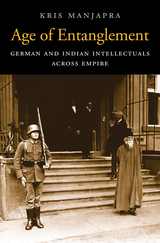
Age of Entanglement explores patterns of connection linking German and Indian intellectuals from the nineteenth century to the years after the Second World War. Kris Manjapra traces the intersecting ideas and careers of a diverse collection of individuals from South Asia and Central Europe who shared ideas, formed networks, and studied one another’s worlds. Moving beyond well-rehearsed critiques of colonialism towards a new critical approach, this study recasts modern intellectual history in terms of the knotted intellectual itineraries of seeming strangers.
Collaborations in the sciences, arts, and humanities produced extraordinary meetings of German and Indian minds. Meghnad Saha met Albert Einstein, Stella Kramrisch brought the Bauhaus to Calcutta, and Girindrasekhar Bose began a correspondence with Sigmund Freud. Rabindranath Tagore traveled to Germany to recruit scholars for a new Indian university, and the actor Himanshu Rai hired director Franz Osten to help establish movie studios in Bombay. These interactions, Manjapra argues, evinced shared responses to the cultural and political hegemony of the British empire. Germans and Indians hoped to find in one another the tools needed to disrupt an Anglocentric world order.
As Manjapra demonstrates, transnational intellectual encounters are not inherently progressive. From Orientalism and Aryanism to socialism and scientism, German–Indian entanglements were neither necessarily liberal nor conventionally cosmopolitan, often characterized as much by manipulation as by cooperation. Age of Entanglement underscores the connections between German and Indian intellectual history, revealing the characteristics of a global age when the distance separating Europe and Asia seemed, temporarily, to disappear.

A major reinterpretation of the development of European literary theory, this wide-ranging study offers a new approach to ways of thinking about man's work in general. The book is a history of the idea of convention, the roles it played in the formative stages of English and Continental literary theory and in the development of modern thought.
Lawrence Manley traces the idea of convention to its sources in an ancient debate between philosophers and rhetoricians, whose conflicting views of convention established the terms of the controversy that was revived with new implications during the Renaissance. As a result of related developments in political, legal, moral, religious, and artistic thought, Manley argues, the growing prominence of convention eventually challenged the ancient formulation and brought about a major revision in the order and techniques for the study of human things.
Convention, 1500–1750 discusses literary developments in the context of a much larger debate about the role of convention in the life of man. It attempts to show how this debate marked a transition in intellectual history between ancient and modern views of man's relation to his civilized setting.
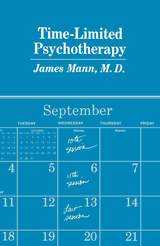
Waiting lists in psychiatric clinics and increasing numbers of patients in long-term psychotherapy have highlighted the need for shorter methods of treatment. Existing forms of short-term psychotherapy tend to be vague and uncertain, lacking as they do a clearly formulated rationale and methodology.
The bold and challenging technique for brief psychotherapy designed around the factor of time itself, which James Mann introduces here, is a method he hopes will revolutionize current practice. The significance of time in human life is examined in terms of the development of time sense as well as its unconscious meaning and the ways these are experienced in both the categorical and existential senses. The author shows how the interplay between the regressive pressures of the child’s sense of infinite time and the adult reality of categorical time determine the patient’s unconscious expectations of psychotherapy.
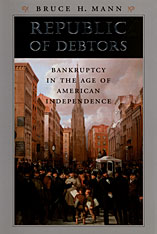
Debt was an inescapable fact of life in early America. At the beginning of the eighteenth century, its sinfulness was preached by ministers and the right to imprison debtors was unquestioned. By 1800, imprisonment for debt was under attack and insolvency was no longer seen as a moral failure, merely an economic setback. In Republic of Debtors, Bruce H. Mann illuminates this crucial transformation in early American society.
From the wealthy merchant to the backwoods farmer, Mann tells the personal stories of men and women struggling to repay their debts and stay ahead of their creditors. He opens a window onto a society undergoing such fundamental changes as the growth of a commercial economy, the emergence of a consumer marketplace, and a revolution for independence. In addressing debt Americans debated complicated questions of commerce and agriculture, nationalism and federalism, dependence and independence, slavery and freedom. And when numerous prominent men—including the richest man in America and a justice of the Supreme Court—found themselves imprisoned for debt or forced to become fugitives from creditors, their fate altered the political dimensions of debtor relief, leading to the highly controversial Bankruptcy Act of 1800.
Whether a society forgives its debtors is not just a question of law or economics; it goes to the heart of what a society values. In chronicling attitudes toward debt and bankruptcy in early America, Mann explores the very character of American society.

This volume explores the earliest available version of the Sikh canon. The book contains the first critical description and partial edition of the Goindval Pothis, a set of proto-scriptural manuscripts prepared in the 1570s. The manuscripts also contain a number of hymns by non-Sikh saints, some of them not found elsewhere.
Through a meticulous analysis of the contents of these rare manuscripts, Gurinder Singh Mann establishes their place and importance in the history of Sikh canon formation.
The book will be of great interest to scholars of comparative canon studies and of medieval Indian literature.


The impact of the AIDS pandemic on health systems and entire societies in the 1990s will be much more severe than it was in the last decade; up-to-date information about the disease is now crucial. Yet even though readers are deluged by technical publications and popularizations, no single book tracks, on an annual basis, the evolution of the pandemic, its effects, and the worldwide response.
To fill this gap, Jonathan Mann, founding director of the World Health Organization's Global Progam on AIDS and currently director of the International AIDS Center at Harvard University, has assembled a team of experts to produce an unprecedented document for our time. AIDS in the World will synthesize the best possible information, data, and thinking about AIDS into a volume that is destined to become a landmark publication. AIDS in the World will provide a vital guide to rekindling the worldwide assault on AIDS. To ensure that AIDS in the World 1992 is both timely and authoritative, the editors have enlisted the support of an extensive team of researchers, specialists, scientists, writers, and experts to provide a solid basis for new and original thinking on a wide range of topics.
This book reviews the status of the disease, including numbers of AIDS cases and deaths; AIDS and HIV prevalence; mortality rates; links between other infections and HlV breakthroughs in biomedical, clinical, and behavioral areas; prevention and care; legislation and human rights issues; and economic and demographic aspects. AIDS in the World 1992 provides a global assessment for where we are now and where we are headed; it spotlights critical issues and highlights communities and countries that may be especially vulnerable to the dissemination of HIV. With publication scheduled before the VIIIth International Conference on AIDS in July 1992, this work will be indispensable for governments, policymakers, scientists, health care workers, and journalists around the world who will rely on this book to make the crucial decisions of this decade and the next.

Poor health habits (drinking, smoking, lack of exercise) obviously take their toll on individuals and their families. The costs to society are less obvious but certainly more far-reaching. This investigation is the first to quantify the financial burden these detrimental habits place on American taxpayers. Willard Manning and his colleagues measure the direct costs of poor health habits (fire damage, motor vehicle accidents, legal fees), as well as collectively financed costs (medical care, employee sick leave, group health and life insurance, nursing home care, retirement pensions, liability insurance). Consider two co-workers covered by their employer's health plan: both pay the same premium, yet if one drinks heavily, the other--through their mutual insurance program--involuntarily funds the resulting health problems.
After laying out their conceptual framework, methods, and analytical approach, the authors describe precisely how and to what extent drinking, smoking, and lack of exercise are currently subsidized, and make recommendations for reducing or reallocating the expense. They present, for example, a persuasive case for raising excise taxes on alcohol. The authors correlate their data to make costs comparable, to avoid double counting, and to determine the exact costs of each of these poor health habits and some of their findings are quite surprising.
This unique study will be indispensable to public health policy specialists and researchers, as well as to health economists.

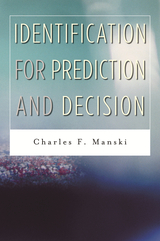
This book is a full-scale exposition of Charles Manski's new methodology for analyzing empirical questions in the social sciences. He recommends that researchers first ask what can be learned from data alone, and then ask what can be learned when data are combined with credible weak assumptions. Inferences predicated on weak assumptions, he argues, can achieve wide consensus, while ones that require strong assumptions almost inevitably are subject to sharp disagreements.
Building on the foundation laid in the author's Identification Problems in the Social Sciences (Harvard, 1995), the book's fifteen chapters are organized in three parts. Part I studies prediction with missing or otherwise incomplete data. Part II concerns the analysis of treatment response, which aims to predict outcomes when alternative treatment rules are applied to a population. Part III studies prediction of choice behavior.
Each chapter juxtaposes developments of methodology with empirical or numerical illustrations. The book employs a simple notation and mathematical apparatus, using only basic elements of probability theory.
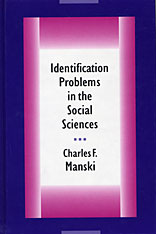
This book provides a language and a set of tools for finding bounds on the predictions that social and behavioral scientists can logically make from nonexperimental and experimental data. The economist Charles Manski draws on examples from criminology, demography, epidemiology, social psychology, and sociology as well as economics to illustrate this language and to demonstrate the broad usefulness of the tools.
There are many traditional ways to present identification problems in econometrics, sociology, and psychometrics. Some of these are primarily statistical in nature, using concepts such as flat likelihood functions and nondistinct parameter estimates. Manski's strategy is to divorce identification from purely statistical concepts and to present the logic of identification analysis in ways that are accessible to a wide audience in the social and behavioral sciences. In each case, problems are motivated by real examples with real policy importance, the mathematics is kept to a minimum, and the deductions on identifiability are derived giving fresh insights.
Manski begins with the conceptual problem of extrapolating predictions from one population to some new population or to the future. He then analyzes in depth the fundamental selection problem that arises whenever a scientist tries to predict the effects of treatments on outcomes. He carefully specifies assumptions and develops his nonparametric methods of bounding predictions. Manski shows how these tools should be used to investigate common problems such as predicting the effect of family structure on children's outcomes and the effect of policing on crime rates.
Successive chapters deal with topics ranging from the use of experiments to evaluate social programs, to the use of case-control sampling by epidemiologists studying the association of risk factors and disease, to the use of intentions data by demographers seeking to predict future fertility. The book closes by examining two central identification problems in the analysis of social interactions: the classical simultaneity problem of econometrics and the reflection problem faced in analyses of neighborhood and contextual effects.
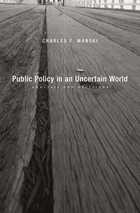
Public policy advocates routinely assert that “research has shown” a particular policy to be desirable. But how reliable is the analysis in the research they invoke? And how does that analysis affect the way policy is made, on issues ranging from vaccination to minimum wage to FDA drug approval? Charles Manski argues here that current policy is based on untrustworthy analysis. By failing to account for uncertainty in an unpredictable world, policy analysis misleads policy makers with expressions of certitude. Public Policy in an Uncertain World critiques the status quo and offers an innovation to improve how policy research is conducted and how policy makers use research.
Consumers of policy analysis, whether civil servants, journalists, or concerned citizens, need to understand research methodology well enough to properly assess reported findings. In the current model, policy researchers base their predictions on strong assumptions. But as Manski demonstrates, strong assumptions lead to less credible predictions than weaker ones. His alternative approach takes account of uncertainty and thereby moves policy analysis away from incredible certitude and toward honest portrayal of partial knowledge. Manski describes analysis of research on such topics as the effect of the death penalty on homicide, of unemployment insurance on job-seeking, and of preschooling on high school graduation. And he uses other real-world scenarios to illustrate the course he recommends, in which policy makers form reasonable decisions based on partial knowledge of outcomes, and journalists evaluate research claims more closely, with a skeptical eye toward expressions of certitude.

Almost everyone would like to see the enactment of sound, practical measures to help disadvantaged people get off welfare and find jobs at decent wages, and over the past quarter-century federal and state governments have struggled to develop just such programs. How do we know whether they are having the hoped-for effect? How do we know whether these vast outlays of money are helping the people they are designed to reach?
All welfare and training programs have been subject to professional evaluations, including social experiments and demonstrations designed to test new ideas. This book reviews what we have discovered from past assessments and suggests how welfare and training programs should be planned for the 1990s. The authors of this volume, each a recognized expert in the evaluation of social programs, do more than summarize what we have learned so far. They clarify why the issue of the proper conduct and interpretation of evaluations has itself been a subject of continuing controversy. In part, the problem is organizational, requiring the integrated efforts of social scientists, public officials, and the professionals who execute evaluations. In addition, there is a dispute about scientific method: should evaluators try to understand the complex social processes that make programs succeed (or fail), or should they focus on inputs and outputs, treating the programs themselves as “black boxes” whose machinery remains hidden?
Evaluating Welfare and Training Programs will be important for policy researchers and evaluation professionals, social scientists concerned with evaluation methods, public officials working in social policy, and students of public policy, economics, and social work.

The most crucial choice a high school graduate makes is whether to attend college or to go to work. Here is the most sophisticated study of the complexities behind that decision.
Based on a unique data set of nearly 23,000 seniors from more than 1,300 high schools who were tracked over several years, the book treats the following questions in detail: Who goes to college? Does low family income prevent some young people from enrolling, or does scholarship aid offset financial need? How important are scholastic aptitude scores, high school class rank, race, and socioeconomic background in determining college applications and admissions? Do test scores predict success in higher education?
Using the data from the National Longitudinal Study of the Class of 1972, the authors present a set of interrelated analyses of student and institutional behavior, each focused on a particular aspect of the process of choosing and being chosen by a college. Among their interesting findings: most high school graduates would be admitted to some four-year college of average quality, were they to apply; applicants do not necessarily prefer the highest-quality school; high school class rank and SAT scores are equally important in college admissions; federal scholarship aid has had only a small effect on enrollments at four-year colleges but a much stronger effect on attendance at two-year colleges; the attention paid to SAT scores in admissions is commensurate with the power of the scores in predicting persistence to a degree. This clearly written book is an important source of information on a perpetually interesting topic.

Just 30 minutes a day of moderate exercise--even walking--can save your life. This is the powerful message that Dr. JoAnn Manson--of the lead investigators of both the Women's Health Initiative and the Nurses' Health Study--and her coauthor Patricia Amend want to send to American women.
Regardless of the barriers you may face--too busy, too tired, too "down," or too old--with this four-step practical plan you'll find the excuses falling away and a happier, healthier self emerging. This book offers not only state-of-the-art information from recent medical research but step-by-step instructions on how to get started and maintain a physically active lifestyle. The authors will help you choose a "core" activity that doesn't disrupt your daily life. Then they will show you how to measure your fitness level at the start, how to monitor your progress over time, and how to reward yourself for your efforts. These four simple steps to fitness will work no matter who you are--25 or 75, harried mother or overworked professional (or both), in good health or living with a chronic disease.
The authors have included a clearly illustrated program of stretching and strength-training exercises; sensible activities for women with health concerns; an intelligent weight-loss plan; guidelines for selecting home exercise equipment and choosing a health club; and much more. With over 100 illustrations, questionnaires, and checklists, this book has everything you need to feel good, look better, and live longer, starting today--it's all just 30 minutes away.






As Karl Marx the icon has fallen along with so many communist regimes, we are left with the mystery of Karl Marx the man, the complexities of a life that has profoundly affected millions. A Requiem for Karl Marx is Frank Manuel's searching meditation on that life, a learned and elegantly written engagement with the man and his work.
Manuel gives us a psychological portrait rendered with sympathy and critical detachment, a probing look at the connections between the private drama of Marx's life and his revolutionary ideas. Manuel pursues these connections from Marx's adolescence and education in Trier through his university studies, marriage to a German baroness, and early affiliation with French and German radical groups. Here we see Marx in moments of youthful rapture, in periods of despair, in maneuvers of blatant hypocrisy, in outbursts of self-mockery. We follow his involuted response to his status as a converted Jew, observe the psychic toll of debilitating bouts of illness, and witness the shattering effects of his aggressive, often brutal conduct toward friend and foe alike. Manuel analyzes in intricate detail the central role of Marx's enduring relationship with Friedrich Engels, which appears to transcend the bounds of friendship, and his changing behavior toward his wife, Jenny, the neurotic and tragic figure who shared his dismal London exile.
What becomes clear in this narrative is the link between Marx's personal life and his ideas about class struggle, revolutionary strategy, and utopia--as well as the impact of his personal vision and political tactics on the movements that followed him, down to our day.
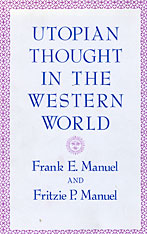
This masterly study has a grand sweep. It ranges over centuries, with a long look backward over several millennia. Yet the history it unfolds is primarily the story of individuals: thinkers and dreamers who envisaged an ideal social order and described it persuasively, leaving a mark on their own and later times.
The roster of utopians includes men of all stripes in different countries and eras--figures as disparate as More and Fourier, the Marquis de Sade and Edward Bellamy, Rousseau and Marx. Fascinating character studies of the major figures are among the delights of the book.
Utopian writings run the gamut from fictional narratives to theoretical treatises, from political manifestos to constitutions for a new society. The Manuels have structured five centuries of utopian invention by identifying successive constellations, groups of thinkers joined by common social and moral concerns. Within this framework they analyze individual writings, in the context of the author's life and of the socio-economic, religious, and political exigencies of his time. Concentrating on innovative works, they highlight disjunctures as well as continuities in utopian thought from the Renaissance through the twentieth century.
Witty and erudite, challenging in its interpretations and provocative in the questions it poses, the Manuels' anatomy of utopia is an adventure in ideas.
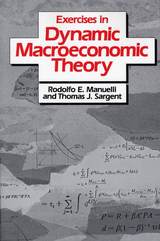



Rhetorical remnants.
The Loeb Classical Library series Fragmentary Republican Latin continues with oratory, an important element of Roman life from the earliest times, essential to running public affairs and for advancing individual careers long before it acquired literary dimensions, which happened once orators decided to write up and circulate written versions of their speeches after delivery.
Beginning with Appius Claudius Caecus (340–273 BC), this three-volume edition covers the full range of speech-making—political, juridical, and epideictic (display)—and with the exceptions of Cato the Elder and Cicero includes all individuals for whom speech-making is attested and for whose speeches quotations, descriptive testimonia, or historiographic recreations survive.
Such an overview provides insight into the typical forms and themes of Roman oratory as well as its wide variety of occasions and styles. By including orators from different phases within the Republican period as well as men given high or low rankings by contemporaries and later ancient critics, the collection offers a fuller panorama of Roman Republican oratory than a selection guided simply by an orator’s alleged or canonical quality, or by the amount of evidence available.
This edition includes all the orators recognized by Malcovati and follows her numbering, but the texts have been drawn from the most recent and reliable editions of the source authors and revised in light of current scholarship; additional material has been included with its own separate numbering. Helping to guide readers through the material are faithful translations, informative introductions, and ample annotation.

Rhetorical remnants.
The Loeb Classical Library series Fragmentary Republican Latin continues with oratory, an important element of Roman life from the earliest times, essential to running public affairs and for advancing individual careers long before it acquired literary dimensions, which happened once orators decided to write up and circulate written versions of their speeches after delivery.
Beginning with Appius Claudius Caecus (340–273 BC), this three-volume edition covers the full range of speech-making—political, juridical, and epideictic (display)—and with the exceptions of Cato the Elder and Cicero includes all individuals for whom speech-making is attested and for whose speeches quotations, descriptive testimonia, or historiographic recreations survive.
Such an overview provides insight into the typical forms and themes of Roman oratory as well as its wide variety of occasions and styles. By including orators from different phases within the Republican period as well as men given high or low rankings by contemporaries and later ancient critics, the collection offers a fuller panorama of Roman Republican oratory than a selection guided simply by an orator’s alleged or canonical quality, or by the amount of evidence available.
This edition includes all the orators recognized by Malcovati and follows her numbering, but the texts have been drawn from the most recent and reliable editions of the source authors and revised in light of current scholarship; additional material has been included with its own separate numbering. Helping to guide readers through the material are faithful translations, informative introductions, and ample annotation.

Rhetorical remnants.
The Loeb Classical Library series Fragmentary Republican Latin continues with oratory, an important element of Roman life from the earliest times, essential to running public affairs and for advancing individual careers long before it acquired literary dimensions, which happened once orators decided to write up and circulate written versions of their speeches after delivery.
Beginning with Appius Claudius Caecus (340–273 BC), this three-volume edition covers the full range of speech-making—political, juridical, and epideictic (display)—and with the exceptions of Cato the Elder and Cicero includes all individuals for whom speech-making is attested and for whose speeches quotations, descriptive testimonia, or historiographic recreations survive.
Such an overview provides insight into the typical forms and themes of Roman oratory as well as its wide variety of occasions and styles. By including orators from different phases within the Republican period as well as men given high or low rankings by contemporaries and later ancient critics, the collection offers a fuller panorama of Roman Republican oratory than a selection guided simply by an orator’s alleged or canonical quality, or by the amount of evidence available.
This edition includes all the orators recognized by Malcovati and follows her numbering, but the texts have been drawn from the most recent and reliable editions of the source authors and revised in light of current scholarship; additional material has been included with its own separate numbering. Helping to guide readers through the material are faithful translations, informative introductions, and ample annotation.
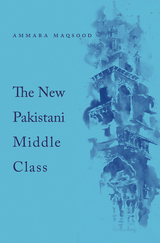
Pakistan’s presence in the outside world is dominated by images of religious extremism and violence. These images—and the narratives that interpret them—inform events in the international realm, but they also twist back around to shape local class politics. In The New Pakistani Middle Class, Ammara Maqsood focuses on life in contemporary Lahore, where she unravels these narratives to show how central they are for understanding competition and the quest for identity among middle-class groups.
Lahore’s traditional middle class has asserted its position in the socioeconomic hierarchy by wielding significant social capital and dominating the politics and economics of urban life. For this traditional middle class, a Muslim identity is about being modern, global, and on the same footing as the West. Recently, however, a more visibly religious, upwardly mobile social group has struggled to distinguish itself against this backdrop of conventional middle-class modernity, by embracing Islamic culture and values. The religious sensibilities of this new middle-class group are often portrayed as Saudi-inspired and Wahhabi.
Through a focus on religious study gatherings and also on consumption in middle-class circles—ranging from the choice of religious music and home décor to debit cards and the cut of a woman’s burkha—The New Pakistani Middle Class untangles current trends in piety that both aspire toward, and contest, prevailing ideas of modernity. Maqsood probes how the politics of modernity meets the practices of piety in the struggle among different middle-class groups for social recognition and legitimacy.
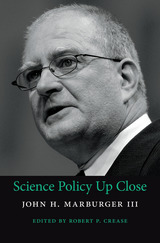
In a career that included tenures as president of Stony Brook University, director of Brookhaven National Laboratory, and science advisor to President George W. Bush, John Marburger (1941–2011) found himself on the front line of battles that pulled science ever deeper into the political arena. From nuclear power to global warming and stem cell research, science controversies, he discovered, are never just about science. Science Policy Up Close presents Marburger’s reflections on the challenges science administrators face in the twenty-first century.
In each phase of public service Marburger came into contact with a new dimension of science policy. The Shoreham Commission exposed him to the problem of handling a volatile public controversy over nuclear power. The Superconducting Super Collider episode gave him insights into the collision between government requirements and scientists’ expectations and feelings of entitlement. The Directorship of Brookhaven taught him how to talk to the public about the risks of conducting high-energy physics and about large government research facilities. As Presidential Science Advisor he had to represent both the scientific community to the administration and the administration to the scientific community at a time when each side was highly suspicious of the other.
What Marburger understood before most others was this: until the final quarter of the twentieth century, science had been largely protected from public scrutiny and government supervision. Today that is no longer true. Scientists and science policy makers can learn from Marburger what they must do now to improve their grip on their own work..

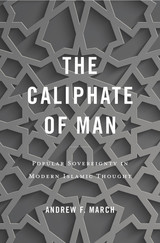
A political theorist teases out the century-old ideological transformation at the heart of contemporary discourse in Muslim nations undergoing political change.
The Arab Spring precipitated a crisis in political Islam. In Egypt Islamists have been crushed. In Turkey they have descended into authoritarianism. In Tunisia they govern but without the label of “political Islam.” Andrew March explores how, before this crisis, Islamists developed a unique theory of popular sovereignty, one that promised to determine the future of democracy in the Middle East.
This began with the claim of divine sovereignty, the demand to restore the sharīʿa in modern societies. But prominent theorists of political Islam also advanced another principle, the Quranic notion that God’s authority on earth rests not with sultans or with scholars’ interpretation of written law but with the entirety of the Muslim people, the umma. Drawing on this argument, utopian theorists such as Abū’l-Aʿlā Mawdūdī and Sayyid Quṭb released into the intellectual bloodstream the doctrine of the caliphate of man: while God is sovereign, He has appointed the multitude of believers as His vicegerent. The Caliphate of Man argues that the doctrine of the universal human caliphate underpins a specific democratic theory, a kind of Islamic republic of virtue in which the people have authority over the government and religious leaders. But is this an ideal regime destined to survive only as theory?

From the exhilarating impact of Isaac Albeniz at the beginning of the century to today's complex and adventurous avant-garde, this complete interpretive history introduces twentieth-century Spanish music to English-speaking readers. With graceful authority, Tomas Marco, award-winning composer, critic, and bright light of Spanish music since the 1960s, covers the entire spectrum of composers and their works: trends and movements, critical and popular reception, national institutions, influences from Europe and beyond, and the effect of such historic events as the Spanish Civil War and the death of Franco. Marco's penetrating aesthetic critiques are threaded throughout each phase of this rich account.
Marco provides detailed coverage of the key figures, induding a chapter devoted entirely to Manuel de Falla—Spain's most celebrated twentieth-century composer—and a panoramic survey of recent arrivals on the contemporary music scene. Exploring the rise and fall of the zarzuela, the author highlights innovative works in this authentic Spanish genre. He analyzes the attempts to find an audience for Spanish opera; demonstrates the flowering of symphonic and chamber music at the beginning of this century; traces currents such as romanticism, impressionism, and neoclassicism; and tracks the influence of Spain's distinctive regional folk traditions. Covering musical innovation after Spain's emergence from its period of isolation, Marco notes the speed with which many composers absorbed the work of Stravinsky and Bartok, the twelve-tone system, aleatory forms, electronic techniques, and other European developments.
English-speaking scholars, musicians, critics and general readers have for decades been without full information on the rich and varied work coming out of Spain in this century. This lively history fills a long-felt need and fills it superbly, with the knowledge and insights of a major figure in the musical world.

Stoic musings of a philosopher-emperor at war.
Marcus Aurelius (AD 121–180), Roman emperor and Stoic philosopher, born at Rome, received training under his guardian and uncle emperor Antoninus Pius (reigned 138–161), who adopted him. He was converted to Stoicism and henceforward studied and practiced philosophy and law. A gentle man, he lived in agreement and collaboration with Antoninus Pius. He married Pius’ daughter and succeeded him as emperor in March 161, sharing some of the burdens with Lucius Verus.
Marcus’ reign soon saw fearful national disasters from flood, earthquakes, epidemics, threatened revolt (in Britain), a Parthian war, and pressure of barbarians north of the Alps. From 169 onwards he had to struggle hard against the German Quadi, Marcomani, Vandals, and others until success came in 174. In 175 (when Faustina died) he pacified affairs in Asia after a revolt by Avidius. War with Germans was renewed during which he caught some disease and died by the Danube in March 180.
The famous Meditations of Marcus Aurelius (not his title; he simply calls them “The matters addressed to himself”) are reflections written in periods of solitude during the emperor’s military campaigns. Originally intended for his private guidance and self-admonition, the Meditations have endured as a potent expression of Stoic belief. It is a central text for students of Stoicism as well as a unique personal guide to the moral life.
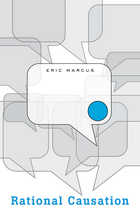
We explain what people think and do by citing their reasons, but how do such explanations work, and what do they tell us about the nature of reality? Contemporary efforts to address these questions are often motivated by the worry that our ordinary conception of rationality contains a kernel of supernaturalism—a ghostly presence that meditates on sensory messages and orchestrates behavior on the basis of its ethereal calculations. In shunning this otherworldly conception, contemporary philosophers have focused on the project of “naturalizing” the mind, viewing it as a kind of machine that converts sensory input and bodily impulse into thought and action. Eric Marcus rejects this choice between physicalism and supernaturalism as false and defends a third way.
He argues that philosophers have failed to take seriously the idea that rational explanations postulate a distinctive sort of causation—rational causation. Rational explanations do not reveal the same sorts of causal connections that explanations in the natural sciences do. Rather, rational causation draws on the theoretical and practical inferential abilities of human beings. Marcus defends this position against a wide array of physicalist arguments that have captivated philosophers of mind for decades. Along the way he provides novel views on, for example, the difference between rational and nonrational animals and the distinction between states and events.

In life, Elvis Presley went from childhood poverty to stardom, from world fame to dissipation and early death. As Greil Marcus shows in this remarkable book, Presley's journey after death takes him even further, pushing him beyond his own frontiers to merge with the American public consciousness—and the American subconscious.
As he listens in on the public conversation that recreates Elvis after death, Marcus tracks the path of Presley's resurrection. He grafts together scattered fragments of the eclectic dialogue—snatches of movies and music, books and newspapers, photographs, posters, cartoons—and amazes us with not only what America has been saying as it raises its late king, but also what this strange obsession with a dead Elvis can tell us about America itself.

"How much history can be communicated by pressure on a guitar string?" Robert Palmer wondered in Deep Blues. Greil Marcus answers here: more than we will ever know. It is the history in the riff, in the movie or novel or photograph, in the actor's pose or critic's posturing--in short, the history in cultural happenstance--that Marcus reveals here, exposing along the way the distortions and denials that keep us oblivious if not immune to its lessons.
Whether writing about the Beat Generation or Umberto Eco, Picasso's Guernica or the massacre in Tiananmen Square, The Manchurian Candidate or John Wayne's acting, Eric Ambler's antifascist thrillers or Camille Paglia, Marcus uncovers the histories embedded in our cultural moments and acts, and shows how, through our reading of the truths our culture tells and those it twists and conceals, we situate ourselves in that history and in the world. Rarely has a history lesson been so exhilarating. With the startling insights and electric style that have made him our foremost writer on American music, Marcus brings back to life the cultural events that have defined us and our time, the social milieu in which they took place, and the individuals engaged in them. As he does so, we see that these cultural instances--as lofty as The Book of J, as humble as a TV movie about Jan and Dean, as fleeting as a few words spoken at the height of the Berkeley Free Speech Movement, as enduring as a Paleolithic painting--often have more to tell us than the master-narratives so often passed off as faultless representations of the past.
Again and again Marcus skewers the widespread assumption that history exists only in the past, that it is behind us, relegated to the dustbin. Here we see instead that history is very much with us, being made and unmade every day, and unless we recognize it our future will be as cramped and impoverished as our present sense of the past.

Was punk just another moment in music history, a flash in time when a group of young rebels exploded in a fury of raw sound, outrageous styles, and in-your-face attitude? Greil Marcus, author of the renowned Lipstick Traces, delves into the after-life of punk as a much richer phenomenon—a form of artistic and social rebellion that continually erupts into popular culture.
In more than seventy short pieces written over fifteen years, he traces the uncompromising strands of punk from Johnny Rotten to Elvis Costello, Sonic Youth, even Bruce Springsteen. Marcus's unparalleled insight into present-day culture and brilliant ear for music bring punk's searing half-life into deep focus. Originally published in the U.S. as Ranters and Crowd Pleasers.

Greil Marcus, author of Mystery Train, widely acclaimed as the best book ever written about America as seen through its music, began work on this new book out of a fascination with the Sex Pistols: that scandalous antimusical group, invented in London in 1975 and dead within two years, which sparked the emergence of the culture called punk. "I am an antichrist!" shouted singer Johnny Rotten--where in the world of pop music did that come from? Looking for an answer, with a high sense of the drama of the journey, Marcus takes us down the dark paths of counterhistory, a route of blasphemy, adventure, and surprise.
This is no mere search for cultural antecedents. Instead, what Marcus so brilliantly shows is that various kinds of angry, absolute demands--demands on society, art, and all the governing structures of everyday life--seem to be coded in phrases, images, and actions passed on invisibly, but inevitably, by people quite unaware of each other. Marcus lets us hear strange yet familiar voices: of such heretics as the Brethren of the Free Spirit in medieval Europe and the Ranters in seventeenth-century England; the dadaists in Zurich in 1916 and Berlin in 1918, wearing death masks, chanting glossolalia; one Michel Mourre, who in 1950 took over Easter Mass at Notre-Dame to proclaim the death of God; the Lettrist International and the Situationist International, small groups of Paris--based artists and writers surrounding Guy Debord, who produced blank-screen films, prophetic graffiti, and perhaps the most provocative social criticism of the 1950s and '60s; the rioting students and workers of May '68, scrawling cryptic slogans on city walls and bringing France to a halt; the Sex Pistols in London, recording the savage "Anarchy in the U.K." and "God Save the Queen."
Although the Sex Pistols shape the beginning and the end of the story, Lipstick Traces is not a book about music; it is about a common voice, discovered and transmitted in many forms. Working from scores of previously unexamined and untranslated essays, manifestos, and filmscripts, from old photographs, dada sound poetry, punk songs, collages, and classic texts from Marx to Henri Lefebvre, Marcus takes us deep behind the acknowledged events of our era, into a hidden tradition of moments that would seem imaginary except for the fact that they are real: a tradition of shared utopias, solitary refusals, impossible demands, and unexplained disappearances. Written with grace and force, humor and an insistent sense of tragedy and danger, Lipstick Traces tells a story as disruptive and compelling as the century itself.
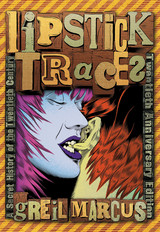
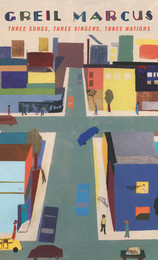
Greil Marcus has been one of the most distinctive voices in American music criticism for over forty years. His books, including Mystery Train and The Shape of Things to Come, traverse soundscapes of folk and blues, rock and punk, attuning readers to the surprising, often hidden affinities between the music and broader streams of American politics and culture.
Drawn from Marcus’s 2013 Massey Lectures at Harvard, his new work delves into three episodes in the history of American commonplace song: Bascom Lamar Lunsford’s 1928 “I Wish I Was a Mole in the Ground,” Geeshie Wiley’s 1930 “Last Kind Words Blues,” and Bob Dylan’s 1964 “Ballad of Hollis Brown.” How each of these songs manages to convey the uncanny sense that it was written by no one illuminates different aspects of the commonplace song tradition. Some songs truly did come together over time without an identifiable author. Others draw melodies and motifs from obscure sources but, in the hands of a particular artist, take a final, indelible shape. And, as in the case of Dylan’s “Hollis Brown,” there are songs that were written by a single author but that communicate as anonymous productions, as if they were folk songs passed down over many generations.
In three songs that seem to be written by no one, Marcus shows, we discover not only three different ways of talking about the United States but three different nations within its formal boundaries.
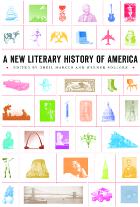
America is a nation making itself up as it goes along—a story of discovery and invention unfolding in speeches and images, letters and poetry, unprecedented feats of scholarship and imagination. In these myriad, multiform, endlessly changing expressions of the American experience, the authors and editors of this volume find a new American history.
In more than two hundred original essays, A New Literary History of America brings together the nation’s many voices. From the first conception of a New World in the sixteenth century to the latest re-envisioning of that world in cartoons, television, science fiction, and hip hop, the book gives us a new, kaleidoscopic view of what “Made in America” means. Literature, music, film, art, history, science, philosophy, political rhetoric—cultural creations of every kind appear in relation to each other, and to the time and place that give them shape.
The meeting of minds is extraordinary as T. J. Clark writes on Jackson Pollock, Paul Muldoon on Carl Sandburg, Camille Paglia on Tennessee Williams, Sarah Vowell on Grant Wood’s American Gothic, Walter Mosley on hard-boiled detective fiction, Jonathan Lethem on Thomas Edison, Gerald Early on Tarzan, Bharati Mukherjee on The Scarlet Letter, Gish Jen on Catcher in the Rye, and Ishmael Reed on Huckleberry Finn. From Anne Bradstreet and John Winthrop to Philip Roth and Toni Morrison, from Alexander Graham Bell and Stephen Foster to Alcoholics Anonymous, Life, Chuck Berry, Alfred Hitchcock, and Ronald Reagan, this is America singing, celebrating itself, and becoming something altogether different, plural, singular, new.

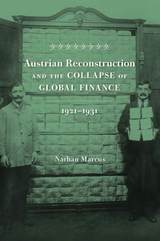
In 1921 Austria became the first interwar European country to experience hyperinflation. The League of Nations, among other actors, stepped in to help reconstruct the economy, but a decade later Austria’s largest bank, Credit-Anstalt, collapsed. Historians have correlated these events with the banking and currency crisis that destabilized interwar Europe—a narrative that relies on the claim that Austria and the global monetary system were the victims of financial interlopers. In this corrective history, Nathan Marcus deemphasizes the destructive role of external players in Austria’s reconstruction and points to the greater impact of domestic malfeasance and predatory speculation on the nation’s financial and political decline.
Consulting sources ranging from diplomatic dossiers to bank statements and financial analyses, Marcus shows how the League of Nations’ efforts to curb Austrian hyperinflation in 1922 were politically constrained. The League left Austria in 1926 but foreign interests intervened in 1931 to contain the fallout from the Credit-Anstalt collapse. Not until later, when problems in the German and British economies became acute, did Austrians and speculators exploit the country’s currency and compromise its value. Although some statesmen and historians have pinned Austria’s—and the world’s—economic implosion on financial colonialism, Marcus’s research offers a more accurate appraisal of early multilateral financial supervision and intervention.
Illuminating new facets of the interwar political economy, Austrian Reconstruction and the Collapse of Global Finance reckons with the true consequences of international involvement in the Austrian economy during a key decade of renewal and crisis.

For most of us the word "desert" conjures up images of barren wasteland, vast, dry stretches inimical to life. But for a great array of creatures, perhaps even more plentiful than those who inhabit tropical rainforests, the desert is a haven and a home. Travel with Michael Mares into the deserts of Argentina, Iran, Egypt, and the American Southwest and you will encounter a rich and memorable variety of these small, tenacious animals, many of them first discovered by Mares in areas never before studied. Accompanying Mares on his forays into these hostile habitats, we observe the remarkable behavioral, physiological, and ecological adaptations that have allowed such little-known species of rodents, bats, and other small mammals to persist in an arid world. At the same time, we see firsthand the perils and pitfalls that await biologists who venture into the field to investigate new habitats, discover new species, and add to our knowledge of the diversity of life.
Filled with the seductions and trials that such adventures entail, A Desert Calling affords an intimate understanding of the biologist's vocation. As he astonishes us with the range and variety of knowledge to be acquired through the determined investigation of little-known habitats, Mares opens a window on his own uncommon life, as well as on the uncommon life of the remote and mysterious corners of our planet.

Much of the intense current interest in collective memory concerns the politics of memory. In a book that asks, "Is there an ethics of memory?" Avishai Margalit addresses a separate, perhaps more pressing, set of concerns.
The idea he pursues is that the past, connecting people to each other, makes possible the kinds of "thick" relations we can call truly ethical. Thick relations, he argues, are those that we have with family and friends, lovers and neighbors, our tribe and our nation--and they are all dependent on shared memories. But we also have "thin" relations with total strangers, people with whom we have nothing in common except our common humanity. A central idea of the ethics of memory is that when radical evil attacks our shared humanity, we ought as human beings to remember the victims.
Margalit's work offers a philosophy for our time, when, in the wake of overwhelming atrocities, memory can seem more crippling than liberating, a force more for revenge than for reconciliation. Morally powerful, deeply learned, and elegantly written, The Ethics of Memory draws on the resources of millennia of Western philosophy and religion to provide us with healing ideas that will engage all of us who care about the nature of our relations to others.
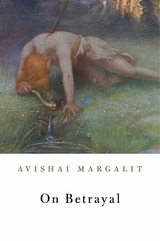
Adultery, treason, and apostasy no longer carry the weight they once did. Yet we constantly see and hear stories of betrayal, and many people have personally experienced a destructive breach of loyalty. Avishai Margalit argues that the tension between the ubiquity of betrayal and the loosening of its hold is a sign of the strain between ethics and morality, between thick and thin human relations. On Betrayal offers a philosophical account of thick human relations—relationships with friends, family, and core communities—through their pathology, betrayal.
Judgments of betrayal often shift unreliably. A whistle-blower to some is a backstabber to others; a traitor to one side is a hero to the other. Yet the notion of what it means to betray is remarkably consistent across cultures and eras. Betrayal undermines thick trust, dissolving the glue that holds our most meaningful relationships together. Recently, public attention has lingered on trust between strangers—on relations that play a central role in the globalized economy. These, according to Margalit, are guided by morality. On Betrayal is about ethics: what we owe to the people and groups that give us our sense of belonging.
Margalit’s clear-sighted account draws on literary, historical, and personal sources, including stories from his childhood during the 1948 Arab-Israeli War. Through its discussion of betrayal, it examines what our thick relationships are and should be and revives the long-discarded notion of fraternity.
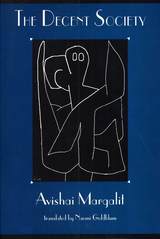
Avishai Margalit builds his social philosophy on this foundation: a decent society, or a civilized society, is one whose institutions do not humiliate the people under their authority, and whose citizens do not humiliate one another. What political philosophy needs urgently is a way that will permit us to live together without humiliation and with dignity.
Most of the philosophical attention nowadays is drawn to the ideal of the just society based on the right balance between freedom and equality. The ideal of the just society is a sublime one but hard to realize. The decent society is an ideal which can be realized even in our children's lifetime. We should get rid of cruelty first, advocated Judith Shklar. Humiliation is a close second. There is more urgency in bringing about a decent society than in bringing about a just one.
Margalit begins concretely where we live, with all the infuriating acts of humiliation that make living in the world so difficult. He argues in a concrete way in the spirit of Judith Shklar and Isaiah Berlin. This is a social philosophy that resists all those menacing labels that promote moral laziness, just as it urges us to get beyond the behavior that labels other human beings. Margalit can't be earmarked as liberal or conservative. If a label is necessary, then the most suitable is George Orwell's humane socialism, a far cry from Animal Farm socialism with its many tools of oppression. How to be decent, how to build a decent society, emerges out of Margalit's analysis of the corrosive functioning of humiliation in its many forms. This is a thoroughly argued and, what is much more, a deeply felt book that springs from Margalit's experience at the borderlands of conflicts between Eastern Europeans and Westerners, between Palestinians and Israelis.
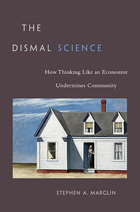
Economists celebrate the market as a device for regulating human interaction without acknowledging that their enthusiasm depends on a set of half-truths: that individuals are autonomous, self-interested, and rational calculators with unlimited wants and that the only community that matters is the nation-state. However, as Stephen A. Marglin argues, market relationships erode community. In the past, for example, when a farm family experienced a setback—say the barn burned down—neighbors pitched in. Now a farmer whose barn burns down turns, not to his neighbors, but to his insurance company. Insurance may be a more efficient way to organize resources than a community barn raising, but the deep social and human ties that are constitutive of community are weakened by the shift from reciprocity to market relations.
Marglin dissects the ways in which the foundational assumptions of economics justify a world in which individuals are isolated from one another and social connections are impoverished as people define themselves in terms of how much they can afford to consume. Over the last four centuries, this economic ideology has become the dominant ideology in much of the world. Marglin presents an account of how this happened and an argument for righting the imbalance in our lives that this ideology has fostered.

What determines the rate of growth, the distribution of income, and the structure of relative prices under capitalism? What, in short, makes capitalist economies tick? This watershed treatise analyzes the answers to these questions provided by three major theoretical traditions: neoclassical, neo-Marxian, and neo-Keynesian. Until now, the mutual criticism exchanged by partisans of the different traditions has focused disproportionately on the logical shortcomings of rival theories, or on such questions as whether or not input–output relationships can be described by a continuous-substitution production function.
In this book, these are at best secondary issues. The real distinguishing features of the theories, for Stephen Marglin, are their characterization of labor markets and capital accumulation. For clarity, Marglin first sets out the essential features of each theory in the context of a common production model with a single good and a fixed-coefficient technology. He then formalizes the different theories as alternative ways of closing the model. In subsequent chapters he examines the effects of relaxing key simplifying assumptions, in particular the characterization of technology and the homogeneity of output and capital. And although his primary emphasis is theoretical, he does not ignore the problem of empirically testing the theories. Finally, he synthesizes the insights of the neo-Marxian and neo-Keynesian models into a single model that transcends the shortcomings of each taken separately.
Marglin anticipates that partisans of the different traditions will agree on one point: each will allow that the book reveals the shortcomings of the other theories but will insist that it fails utterly to reflect the power and majesty of one’s own particular brand of truth. Growth, Distribution, and Prices will be controversial, but it will not be ignored.
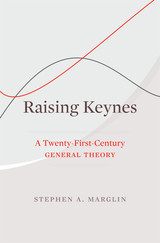
Back to the future: a heterodox economist rewrites Keynes’s General Theory of Employment, Interest, and Money to serve as the basis for a macroeconomics for the twenty-first century.
John Maynard Keynes’s General Theory of Employment, Interest, and Money was the most influential economic idea of the twentieth century. But, argues Stephen Marglin, its radical implications were obscured by Keynes’s lack of the mathematical tools necessary to argue convincingly that the problem was the market itself, as distinct from myriad sources of friction around its margins.
Marglin fills in the theoretical gaps, revealing the deeper meaning of the General Theory. Drawing on eight decades of discussion and debate since the General Theory was published, as well as on his own research, Marglin substantiates Keynes’s intuition that there is no mechanism within a capitalist economy that ensures full employment. Even if deregulating the economy could make it more like the textbook ideal of perfect competition, this would not address the problem that Keynes identified: the potential inadequacy of aggregate demand.
Ordinary citizens have paid a steep price for the distortion of Keynes’s message. Fiscal policy has been relegated to emergencies like the Great Recession. Monetary policy has focused unduly on inflation. In both cases the underlying rationale is the false premise that in the long run at least the economy is self-regulating so that fiscal policy is unnecessary and inflation beyond a modest 2 percent serves no useful purpose.
Fleshing out Keynes’s intuition that the problem is not the warts on the body of capitalism but capitalism itself, Raising Keynes provides the foundation for a twenty-first-century macroeconomics that can both respond to crises and guide long-run policy.

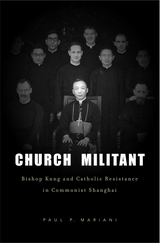
By 1952 the Chinese Communist Party had suppressed all organized resistance to its regime and stood unopposed, or so it has been believed. Internal party documents—declassified just long enough for historian Paul Mariani to send copies out of China—disclose that one group deemed an enemy of the state held out after the others had fallen. A party report from Shanghai marked “top-secret” reveals a determined, often courageous resistance by the local Catholic Church. Drawing on centuries of experience in struggling with the Chinese authorities, the Church was proving a stubborn match for the party.
Mariani tells the story of how Bishop (later Cardinal) Ignatius Kung Pinmei, the Jesuits, and the Catholic Youth resisted the regime’s punishing assault on the Shanghai Catholic community and refused to renounce the pope and the Church in Rome. Acting clandestinely, mirroring tactics used by the previously underground CCP, Shanghai’s Catholics persevered until 1955, when the party arrested Kung and 1,200 other leading Catholics. The imprisoned believers were later shocked to learn that the betrayal had come from within their own ranks.
Though the CCP could not eradicate the Catholic Church in China, it succeeded in dividing it. Mariani’s secret history traces the origins of a deep split in the Chinese Catholic community, where relations between the “Patriotic” and underground churches remain strained even today.

In Consumption Behavior and the Effects of Government Fiscal Policies, Randall Mariger explores how people make decisions about how much to consume and save over their lifetimes. An understanding of these issues illuminates not only individual behavior but important properties of the macro economy as well. The most popular framework for analyzing consumption has been the life-cycle theory. Mariger tests two fundamental, and controversial, assumptions underlying the theory—that there are no planned bequests and that human capital is marketable. To do this, he fits a structural consumption model that incorporates endogenous liquidity constraints (non-marketability of human capital), but no planned bequests, to data on a cross-section of U. S. families. This estimated model, in conjunction with estimates of alternative models, enables him to make inferences about the respective effects of liquidity constraints and social security wealth on consumption. This latter effect yields indirect evidence concerning planned bequests. Mariger also presents direct evidence concerning bequest behavior.
Among his findings are that the model fits the data very well in spite of its tight theoretical structure; that liquidity constraints are prevalent and have important effects on consumption behavior; that planned bequests appear not to be common among families in the lower 99.1% of the wealth distribution; and that families in the upper 0.9% of the wealth distribution appear to plan substantial bequests. Mariger devotes the latter part of his book to studying the implications of his estimated consumption model for the effects of government fiscal policies. More specifically, he simulates the model to infer the effects of government tax/debt policy, as well as those of the social security system, on aggregate savings.

In demanding equal rights and the vote for women, woman suffragists introduced liberal feminist dissent into an emerging national movement against absolute power in the forms of patriarchy, church administrations, slavery, and false dogmas.
In their struggle, these women developed three types of liberal arguments, each predominant during a different phase of the movement. The feminism of equal rights, which called for freedom through equality, emerged during the Jacksonian era to counter those opposed to women's public participation in antislavery reform. The feminism of fear, the defense of women's right to live free from fear of violent injury or death perpetrated particularly by drunken men, flourished after the Civil War. And in the early 1900s, the feminism of personal development called for women's freedom through opportunities to become full persons.
The practical need to blend concepts in order to justify and achieve goals created many contradictions in the suffragists' ideologies. By putting suffrage first, these women introduced radical goals, but as a politically powerless group, they could not win the vote without appeals and bargains that men considered acceptable. Ironically, American woman suffragists used illiberal ideals and arguments to sustain the quest for the most fundamental liberal feminist citizenship goal: the vote.
In this book, Suzanne Marilley reframes the debate on this important topic in a fresh, provocative, and persuasive style.

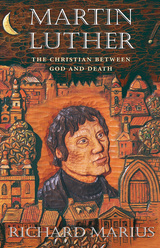
Few figures in history have defined their time as dramatically as Martin Luther. And few books have captured the spirit of such a figure as truly as this robust and eloquent life of Luther. A highly regarded historian and biographer and a gifted novelist and playwright, Richard Marius gives us a dazzling portrait of the German reformer--his inner compulsions, his struggle with himself and his God, the gestation of his theology, his relations with contemporaries, and his responses to opponents. Focusing in particular on the productive years 1516-1525, Marius' detailed account of Luther's writings yields a rich picture of the development of Luther's thought on the great questions that came to define the Reformation.
Marius follows Luther from his birth in Saxony in 1483, during the reign of Frederick III, through his schooling in Erfurt, his flight to an Augustinian monastery and ordination to the outbreak of his revolt against Rome in 1517, the Wittenberg years, his progress to Worms, his exile in the Wartburg, and his triumphant return to Wittenberg. Throughout, Marius pauses to acquaint us with pertinent issues: the question of authority in the church, the theology of penance, the timing of Luther's "Reformation breakthrough," the German peasantry in 1525, Müntzer's revolutionaries, the whys and hows of Luther's attack on Erasmus.
In this personal, occasionally irreverent, always humane reconstruction, Luther emerges as a skeptic who hated skepticism and whose titanic wrestling with the dilemma of the desire for faith and the omnipresence of doubt and fear became an augury for the development of the modern religious consciousness of the West. In all of this, he also represents tragedy, with the goodness of his works overmatched by their calamitous effects on religion and society.


The province of Galicia was the easternmost land of the old Habsburg Empire. Throughout the nineteenth century it was noted for political conflicts and the cultural vibrancy of its three major national groups: Poles, Ukrainians, and Jews.
This volume brings together for the first time eleven essays on various aspects of the last seventy-five years of Austrian Galicia's existence. Included are general surveys on Galicia within the imperial Habsburg system and on the fate of Ukrainians, Poles, and Jews within the province. Various aspects of Ukrainian development receive special attention, and a major bibliographic essay completes the volume. Among the leading specialists represented are Peter Brock, Paul R. Magocsi, Ezra Mendelsohn, Ivan L. Rudnytsky, and Piotr Wandycz.





In early nineteenth-century Japan—the “silver age” of Edo-period literature—Ryutei Tanehiko was a well-known author of popular illustrated fiction. This account of his life and works covers his early yomihon (lengthy romances of improbable perils and adventures) and his gokan (intricately plotted stories in simple language intended for a general audience). Special emphasis is given his most popular work—the illustrated serial Nise Muraskai inaka Genji (An impostor Murasaki and rustic Genji), which ran for fourteen years—Japan's first national bestseller.
Andrew Markus deftly shows how Tanehiko transposed episodes of the eleventh-century Genji monogatari to a fifteenth-century Muromachi setting in a plot dependent on the conventions of nineteenth-century kabuki. Markus fleshes out Tanehiko's diaries and the remarks of his contemporaries to create a fascinating picture of an author who, after years of spectacular success, fell victim to the Tenpo Reform promulgations against “morally inappropriate” publications and whose mysterious death sent shock waves through the publishing world.
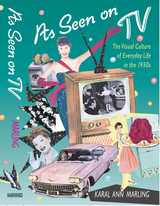
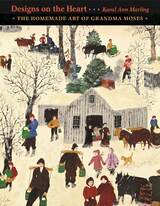
It is a story that has gone down in the annals of American art history: a New Yorker visiting upstate Hoosick Falls is entranced by four pictures hanging in the window of a drugstore. Investigating further, he learns they are the handiwork of a 78-year-old widow. Thus begins the rise to fame of Grandma Moses—farmwife, painter, and unlikely celebrity.
In this book Karal Ann Marling, distinguished observer of American visual culture, looks at Grandma Moses as a cultural phenomenon of the postwar period and explores the meaning of her subject matter—and her astonishing fame. What did the “Greatest Generation” see in her simple renderings of people, young and old, tapping maple trees for syrup, making apple butter, gliding across snowy fields on sleighs? Why did Bob Hope, Irving Berlin, and Harry Truman all love her—and the art czars of New York openly despise her? Through the flood of Moses merchandise—splashed across Christmas cards, dishware, yard goods, and gewgaws of every kind—Marling traces the resonances that these “primitive” images struck in an America awkwardly adjusting to a new era of technology, suburbia, and Cold War tensions.
Between the cultural ephemera, folklore, song, and history embedded in Moses’s paintings and the potent advertising shorthand for Americana that her images rapidly became, this book reveals the widespread longing for the memories, comforts, and small victories of a mythic, intimate American past tapped by the phenomenon—in art and commerce alike—of Grandma Moses.

George Washington: Revolutionary general, Father of His Country, first president, authentic hero, prime mover in establishing a constitutional government, squire of Mount Vernon, itself a national shrine. The sheer ubiquity of his persona makes him an excellent focus for understanding how Americans from the centennial of the nation's birth to the present have rediscovered their colonial origins and have manipulated what they found for a variety of social, economic, and political purposes. The more modern we become, says Karal Ann Marling, the more desperately we cling to our Washingtons, to our old-fashioned heroes, to an imaginary lost paradise chock-full of colonial furniture.
Marling has pursued the figure of Washington from flea markets to World's Fairs in order to understand his significance in American culture and iconography. Of all American heroes, she points out, Washington is the one most closely tied to artifacts, relics, material possessions, style. She describes the Philadelphia Centennial Exposition of 1876, where the federal government exhibited a scene of camp life at Valley Forge, complete with Washington's coat, pants, and other personal objects that lent a strong domestic flavor to the nascent colonial revival. When the restoration of Mount Vernon was begun in the late nineteenth century, it was financed and directed by women, as was much of the historic preservation of the period. Thanks to these efforts, the American home became the scene of successive waves of a revivalism that is still very alive in the 1980s.
In describing Washington's talismanic importance, Marling shows the efforts of twentieth-century politicians to co-opt his incorruptible image. When Harding wanted to convince Americans of his reliability and probity, he campaigned from the Colonial Revival porch of his house on Mount Vernon Avenue in Marion, Ohio. The Washington image was mined for the campaigns that celebrated Calvin Coolidge's Puritan simplicity and Herbert Hoover's engineering talents, said to be related to George Washington's career as a surveyor; more recently, Ronald Reagan at his second inaugural invoked the vision of the humble general praying in the snow at Valley Forge. The neutral and flexible Washington became whatever people wanted him to be—the decorators' darling, the doyen of the D.A.R., the model citizen held up as an example to unruly children and immigrants.
But Marling's book is about more than George Washington and the different ways in which Americans have made use of their past. In her quest for the unhistorical George, Marling has examined the subculture of American life—magazine fiction, historical romances, movies (both silent and talking), and journalism. She traces the descent of high art into such popular forms as posters, plaques, packages, and billboards, all to illuminate how Washington's iconic meaning has influenced styles and tastes on many levels.

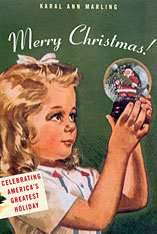
It wouldn't be Christmas without the "things." How they came to mean so much, and to play such a prominent role in America's central holiday, is the tale told in this delightful and edifying book. In a style characteristically engaging and erudite, Karal Ann Marling, one of our most trenchant observers of American culture, describes the outsize spectacle that Christmas has become, showing us the provenance and significance of each of its essential parts: the decorated trees and holiday lights, the cards and gifts and wrapping papers, the toy villages and store displays and Macy's holiday parade, Bing Crosby and Santa Claus.
Viewing Christmas through the media of mass culture--engravings and lithographs, magazine fiction, pictorial ads, news photos, cards, and movies--Marling tells us how the beloved Christmas tree grew out of a much-reprinted image of Queen Victoria and her family gathered around a decorated fir; how Santa Claus lost his provincial Dutch character and turned into the jolly old soul we know; how Charles Dickens's A Christmas Carol borrowed from Washington Irving's imaginings of what Christmas must have been like in Merrie Olde England; and how the holiday, balancing between the private and public realms, conferred a central and defining role on women.
A celebration of the visual culture of the season, Merry Christmas! offers captivating evidence that Christmas in America is primarily a secular celebration of abundance, goodwill, and familial identity, expressed in a multitude of material ways.

In the split second that it took Associated Press photographer Joe Rosenthal to snap the shutter of his Speed Graphic, a powerful and enduring American symbol was born. Iwo Jima: Monuments, Memories, and the American Hero tells the story of that icon as it appeared over the next forty years in bond drive posters, stamps, Hollywood movies, political cartoons, and sculpture, most notably the colossal Marine Corps War Memorial outside Washington, D.C. The book is also a brilliant and moving study of the soldiers who fought one of our bloodiest battles and of the impact of Iwo Jima on the rest of their lives.
When the famous photograph first appeared in newspapers in 1945 it was little more than a grainy outline of massed men and their wafting flag, but for millions it captured the essence of American grit and determination. The Marines pictured were in fact in no immediate danger—they were replacing a small flag planted earlier atop Mt. Suribachi with a larger, more visible one—but to an enthusiastic public they were heroes risking their lives for Old Glory. The Battle of Iwo Jima raged for many days beyond the capture of this one position, and ultimately claimed the lives of almost seven thousand American servicemen, yet already the tableau symbolized victory and, as a politician said at the time, “the dauntless permanency of the American spirit.”
With passion and meticulous care Karal Ann Marling and John Wetenhall illuminate the ironies and misconceptions that proliferated around the two Iwo Jima flag raisings. Pride and nostalgia exalted the glorious epiphany of Rosenthal’s image and suppressed the grisly and at times mundane reality of war. The ordinary men whose action had been immortalized became uneasy celebrities, while the planters of the first flag were doomed to oblivion. From John Wayne’s epic Sands of Iwo Jima to the gargantuan bronze boots of the War Memorial to the parade-floats of Mt. Suribachi done in sweet peas and orchid-colored pompoms, overwrought patriotism blended with true valor.
The authors weave a fast-paced and vivid story from the reminiscences of survivors, rare archival sources, and dozens of documentary photographs. They give the first comprehensive account of the building of the Marine Corps War Memorial, dedicated in 1954. And in a riveting final chapter they follow a group of American veterans who returned to the island in 1985 and met Japanese survivors. Dedicated to the men who fought on Iwo Jima, this groundbreaking study in cultural iconography transcends the icon to show the honor in remembering what really happened.

In the context of a growing scholarly literature devoted to the topics of biography and autobiography, especially in the Arabic literary tradition, the essays in this volume explore the forms and meanings of these genres with particular reference to Persian writings, as well as to writings in Arabic and Turkish that were also composed in Persianate societies.
The authors address, among other topics, biographies and autobiographies of women; biographies of specific occupational groups, such as poets; the relation of traditional “lives of poets” to the reception of their literary works; intertextuality across biographical and autobiographical writings and across languages; and the processes involved in translating written biographies for the contemporary television screen.
Readers are invited to glimpse the lives of figures from the past and to appreciate the historical, cultural, and literary contexts that shaped their biographical and autobiographical narratives, and to reflect on the continuing significance of these narratives into the modern era.

Descriptions of dreams abound in the literatures of the Near East and North Africa. The Prophet Muhammad endowed them with a theological dimension, saying that after him “true dreams” would be the only channel for prophecy. Dreams were often used to support conflicting theological and political arguments, and the local chronicles contain many accounts of royal dreams justifying the advent of new dynasties.
This volume explores the context of these theological speculations and political aspirations through the medium of dreams to present fascinating insights into the social history of the pre-modern Islamic world in all its cultural diversity. Wider cultural exchanges are discussed through concrete examples such as the Arabic version of the Aristotelian treatise De divinatione per somnum. Some of the current scholarly assumptions about dreams being merely stylized expressions of social conventions are challenged by personal reports that express individual personalities, self-awareness, and spiritual development.
This is the first volume of the Ilex Series on Themes and Traditions. The series explores cross-cultural constructs without losing sight of the rich texture of local variations of traditions or beliefs.

READERS
Browse our collection.
PUBLISHERS
See BiblioVault's publisher services.
STUDENT SERVICES
Files for college accessibility offices.
UChicago Accessibility Resources
home | accessibility | search | about | contact us
BiblioVault ® 2001 - 2024
The University of Chicago Press









